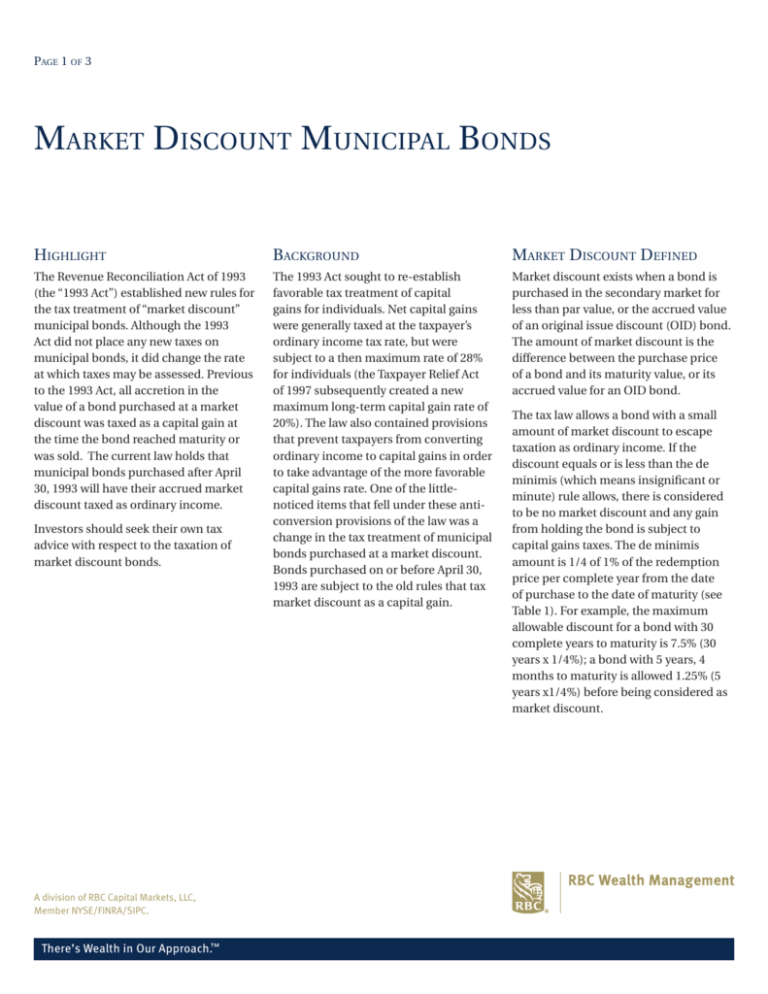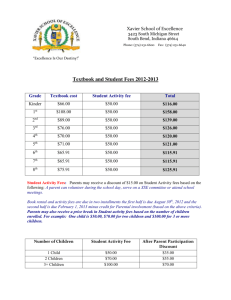
Page 1 of 3
Market Discount Municipal Bonds
Highlight
Background
Market Discount Defined
The Revenue Reconciliation Act of 1993
(the “1993 Act”) established new rules for
the tax treatment of “market discount”
municipal bonds. Although the 1993
Act did not place any new taxes on
municipal bonds, it did change the rate
at which taxes may be assessed. Previous
to the 1993 Act, all accretion in the
value of a bond purchased at a market
discount was taxed as a capital gain at
the time the bond reached maturity or
was sold. The current law holds that
municipal bonds purchased after April
30, 1993 will have their accrued market
discount taxed as ordinary income.
The 1993 Act sought to re-establish
favorable tax treatment of capital
gains for individuals. Net capital gains
were generally taxed at the taxpayer’s
ordinary income tax rate, but were
subject to a then maximum rate of 28%
for individuals (the Taxpayer Relief Act
of 1997 subsequently created a new
maximum long-term capital gain rate of
20%). The law also contained provisions
that prevent taxpayers from converting
ordinary income to capital gains in order
to take advantage of the more favorable
capital gains rate. One of the littlenoticed items that fell under these anticonversion provisions of the law was a
change in the tax treatment of municipal
bonds purchased at a market discount.
Bonds purchased on or before April 30,
1993 are subject to the old rules that tax
market discount as a capital gain.
Market discount exists when a bond is
purchased in the secondary market for
less than par value, or the accrued value
of an original issue discount (OID) bond.
The amount of market discount is the
difference between the purchase price
of a bond and its maturity value, or its
accrued value for an OID bond.
Investors should seek their own tax
advice with respect to the taxation of
market discount bonds.
A division of RBC Capital Markets, LLC,
Member NYSE/FINRA/SIPC.
There’s Wealth in Our Approach.™
The tax law allows a bond with a small
amount of market discount to escape
taxation as ordinary income. If the
discount equals or is less than the de
minimis (which means insignificant or
minute) rule allows, there is considered
to be no market discount and any gain
from holding the bond is subject to
capital gains taxes. The de minimis
amount is 1/4 of 1% of the redemption
price per complete year from the date
of purchase to the date of maturity (see
Table 1). For example, the maximum
allowable discount for a bond with 30
complete years to maturity is 7.5% (30
years x 1/4%); a bond with 5 years, 4
months to maturity is allowed 1.25% (5
years x1/4%) before being considered as
market discount.
Page 2 of 3 | Market Discount Municipal Bonds, continued
Table 1: Allowable Market Discounts Before Taxation as Ordinary Income
Complete Years
to Maturity
Allowable Discount
Complete Years
to Maturity
Allowable Discount
Complete Years
to Maturity
Allowable Discount
1
0.25
11
2.75
21
5.25
2
0.50
12
3.00
22
5.50
3
0.75
13
3.25
23
5.75
4
1.00
14
3.50
24
6.00
5
1.25
15
3.75
25
6.25
6
1.50
16
4.00
26
6.50
7
1.75
17
4.25
27
6.75
8
2.00
18
4.50
28
7.00
9
2.25
19
4.75
29
7.25
10
2.50
20
5.00
30
7.50
Original Issue Discount
(Oid) Bonds
Bonds issued at a price below par value
are original issue discount or “OID”
bonds. Under the revised rules for OID
bonds, the treatment required is the
same as for bonds issued at par, but
the calculations are more involved. The
investor is required to calculate the
accrual of both the tax-free OID and the
taxable market discount to determine
the amounts of each type of income.
The original discount on a municipal
OID bond is accrued over the life of
the bond —even though no income is
reported or taxes paid — for the purpose
of determining gain or loss if the bond
is sold prior to maturity. Calculation of
market discount for OID bonds involves
first calculating the revised issue price.
For tax exempt OID bonds this is
calculated annually using the constant
interest rate method and is equal to the
original issue price plus accrued OID
through the date of purchase. For OID
bonds market discount is the excess, if
any, of the revised issue price over the
purchase price.
When a market discount OID bond is
held to maturity, the entire amount of
the market discount will be taxed as
ordinary income, but the accrual of
remaining OID is tax-free. The amount
of ordinary income is the difference
between the value of the total discount
(which consists of both market discount
and OID) and the value of the OID. If
an OID bond is sold prior to maturity,
the amount of ordinary income is the
difference between the accrued value of
the total discount and the accrued value
of the OID. Table 2 shows an example of
the accrual of total discount and OID.
Page 3 of 3 | Market Discount Municipal Bonds, continued
Table 2: Example of Accrual of Total Market Discount and OID1
30-year OID bond originally issued at 96.24 to yield 5.25%, purchased in the secondary market five years later at 87.14 to yield
6.00% when the adjusted issue price is 96.54; market discount taxable as ordinary income is 9.40 (96.54 - 87.14).
Total
Years
Held
Tax
Market
Discount
–
Free Gain
=
Ordinary
Income
Total
Years
Held
Tax
Market
Discount
–
Free Gain
=
Ordinary
Income
Total
Years
Held
Tax
Market
Discount
–
Free Gain
=
Ordinary
Income
1
0.23
0.07
0.16
11
3.48
1.00
2.48
21
9.36
2.57
6.79
2
0.48
0.14
0.34
12
3.93
1.12
2.81
22
10.16
2.77
7.39
3
0.74
0.22
0.52
13
4.40
1.25
3.15
23
11.01
2.99
8.02
4
1.01
0.30
0.71
14
4.90
1.39
3.51
24
11.91
3.22
8.69
5
1.31
0.39
0.92
15
5.43
1.53
3.90
25
12.86
3.46
9.40
6
1.62
0.48
1.14
16
5.99
1.68
4.31
7
1.95
0.57
1.38
17
6.58
1.84
4.7
8
2.30
0.67
1.63
18
7.22
2.01
5.25
9
2.67
0.77
1.90
19
7.89
2.19
5.70
10
3.06
0.89
2.17
20
8.60
2.37
6.23
OID Bond Examples : A – C
A. Calculation of market discount (30year bond with 25 complete years
remaining to maturity)
No Market Discount
Market Discount
Bond
Coupon:
5.00% Coupon
Yield at
Issue:
Yield at
5.50%
Issue:
5.25%
Issue Price:
92.69 Issue Price:
96.24
Adjusted
Issue Price:
Current
Price:
Yield to
Maturity:
Adjusted
Issue Price:
Current
88.31
Price:
Yield to
6.00%
Maturity:
Market
Discount:
93.25
4.94
(Less than de minimis
amount of 6.25)
Market
Discount:
5.00%
96.54
87.14
B. Taxation if held to maturity (25 years)
No Market Discount
Par:
Purchase
Price:
Capital
Gain:
Tax-Free
Gain:
Current
Price:
Market Discount
Bond
100.00 Par:
88.31
4.94
6.75
88.31
Purchase
Price:
Ordinary
Income:
Tax-Free
Gain:
Current
Price:
100.00
87.14
9.40
3.46
C.Taxation if sold 5 years prior to
maturity (held for 20 years)
No Market Discount
Selling
Price:
Purchase
Price:
Capital
Gain:
Tax-Free
Gain:
96.15
88.31
4.90
2.94
Market Discount
Bond
Selling
95.74
Price:
Purchase
87.14
Price:
Ordinary
6.23
Income:
Tax-Free
2.37
Gain:
87.14
6.00%
9.40
(Exceeds de minimis
amount of 6.25)
All accrual schedules are calculated using the effective-interest method for both market discount and OID. The taxpayer may elect to use the straight-line method for
accruing market discount. Straight-line accrual, while simpler to calculate, has the disadvantage of increasing the amount of market discount amortized in the early
years, which may result on higher taxable income if the bond is sold in the early years of its remaining life. Amortization of original issue discount (OID) must be done
using the effective interest rate method.
RBC Wealth Management is not a tax advisor. All decisions regarding the tax implications of your investments should be made in consultation with your independent
tax advisor.
© 2014 RBC Capital Markets, LLC. All rights reserved.
3663 (01/14)







